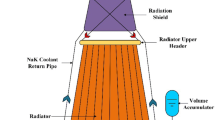Abstract
For future space transportation and planetary exploration mission power applications, NASA Glenn Research Center (GRC) is currently developing a small-scale nuclear fission system (i.e. Kilopower system), which has an operable range of 1 to 10 kWe and a design life of 8 to 15 years. The thermal management system of Kilopower system involves two types of heat pipes: high temperature alkali metal heat pipes that are used to transport thermal energy from the nuclear reactor to the Stirling convertors hot end and titanium water heat pipes that are used to remove the waste heat from the convertors cold end and transport it to the radiators for ultimate rejection. This paper presents the development of the titanium water heat pipes, which are featured with a special wick structure design: it has bi-porous screened evaporator and screen-groove hybrid wick in the adiabatic and condenser sections. This will allow the heat pipe to (1) operate in space with zero gravity (2) operate on planetary surface with gravity-aided orientation (3) be tested on ground with slight adverse gravity orientation and (4) to startup smoothly after being frozen. Under a research and development program, several freeze/thaw tolerant heat pipes were designed, fabricated and experimentally validated. Later, various heat pipe radiators were developed and tested in a thermal vacuum chamber (TVC). Test results successfully demonstrated that the titanium heat pipes with radiator attached are able to transfer the required power at the working temperature of 400 K under space-like testing conditions with a thermal resistance of 0.019 °C/W while the total heat pipe radiator weight is less than 0.73 kg.

















Similar content being viewed by others
Abbreviations
- A :
-
Liquid flow area
- D h :
-
Hydraulic diameter
- fRe :
-
Poiseuille number for a trapezoidal groove
- fv :
-
Vapor friction factor in a circular pipe
- h fg :
-
Latent heat of vaporization
- P :
-
Pressure
- Q :
-
Heat input
- r :
-
Meniscus radius
- S eff :
-
Shear area between liquid and vapor flow
- V :
-
Speed of vapor flow
- z :
-
Axial direction
- θ :
-
Inclination angle (rad)
- ρ :
-
Density
- μ :
-
Viscosity (Pa-s)
References
Ababneh, M. T., Tarau, C. & Anderson, W. G., 2016. Hybrid Variable and Constant Conductance Heat Pipes for Lunar and Martian Environments and High Heat Flux Space Applications. Jeju, s.n
Beard, D., Tarau, C. & Anderson, W. G., 2017a. Sodium heat pipes for space and surface fission power generation. Altanta, GA, s.n
Beard, D. et al., 2017b. High temperature water heat pipes for Kilopower system. Atlanta, GA, s.n
Do, K.H., Kim, S.J., Garimella, S.V.: A mathematical model for analyzing the thermal characteristics of a flat micro heat pipe with a groove wick. International Journal of Heat and Mas Transfer. 51, 4637–4650 (2008)
Gibson, M. A., Oleson, S. R., Poston, D. I. & McClure, P., 2017. NASA's Kilopower reactor development and the path to higher power missions. Big sky, MT, s.n
Gibson, M. et al., 2018. The Kilopower reactor using Stirling TechnologY (KRUSTY) nuclear ground test results and lessons learned. Cincinnati, OH, s.n
Hay, R. & Anderson, W. G., 2015. Water-titanium heat pipes for spacecraft fission power. Orlando, FL, s.n
S-bond Technologies, n.d. S-bond Technolgies. [Online] Available at: http://www.s-bond.com/
Acknowledgements
This research was sponsored by NASA Glenn Research Center under Contract NNX15CC06C. ACT would like to thank Maxwell Briggs, Marc Gibson, Jim Sanzi, and Lee Mason for their support and helpful discussions during the program. In addition, special thanks are addressed to Philip Texter, Larry Waltman and Tim Wagner who were the technicians on the program at ACT. Thanks are also due to Derek Beard and Rebecca Hay, former R&D engineers at ACT who contributed to the development of Ti-water heat pipes prototypes under this program.
Author information
Authors and Affiliations
Corresponding author
Additional information
Publisher’s Note
Springer Nature remains neutral with regard to jurisdictional claims in published maps and institutional affiliations.
This article belongs to the Topical Collection: Heat Pipe Systems for Thermal Management in Space
Guest Editors: Raffaele Savino, Sameer Khandekar
Rights and permissions
About this article
Cite this article
Lee, KL., Tarau, C., Anderson, W.G. et al. Titanium-Water Heat Pipe Radiators for Space Fission Power System Thermal Management. Microgravity Sci. Technol. 32, 453–464 (2020). https://doi.org/10.1007/s12217-020-09780-5
Received:
Accepted:
Published:
Issue Date:
DOI: https://doi.org/10.1007/s12217-020-09780-5




